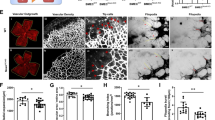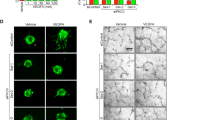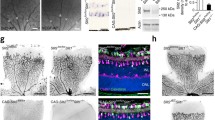Abstract
Vascular endothelial growth factor (VEGF) plays a central role in the development of ocular neovascularization (NV) and is an excellent target for therapeutic intervention. VEGF acts through several receptors, including VEGF receptor 1, VEGF receptor 2, neuropilin-1 (Npn1), and Npn2, but the exact role of these receptors in the development of retinal NV is unknown. In this study, we investigated the expression of npn2 mRNA during new blood vessel growth in the retina and used npn2 knockout mice to assess the impact of deficiency of Npn2 on retinal NV. The level of npn2 mRNA in the retina increased during retinal vascular development, after exposure to hyperoxia, and after the onset of retinal ischemia. Immunohistochemistry showed colocalization of Npn2 with a vascular marker in retinal NV. Compared with littermate controls, mice deficient in Npn2 had significantly less ischemia-induced retinal NV and very little subretinal NV due to expression of a Vegf transgene. These data suggest that Npn2 facilitates VEGF-induced retinal NV and may constitute a useful target for therapeutic intervention in ocular diseases complicated by NV.





Similar content being viewed by others
References
Campochiaro PA. (2000) Retinal and choroidal neovascularization. J. Cell. Physiol. 184:301–10.
The EyeTech Study Group. (2002) Preclinical and phase 1A clinical evaluation of an anti-VEGF pegylated aptamer (EYE001) for the treatment of exudative age-related macular degeneration. Retina 22:143–52.
Schwartz SD et al. (2001) Safety of rhuFab V2, an anti-VEGF antibody fragment, as a single intravitreal injection in subjects with neovascular age-related macular degeneration. Invest. Ophthalmol. Vis. Sci. 42(suppl):S522.
Rosenfeld PJ, Villante N, Feuer WJ, Puliafito CA, McCluskey ER. (2003) RhuFav V2 (Anti-VEGF antibody fragment) in neovascular AMD: safety, tolerability, and efficacy of multiple, escalatin dose intravitreal injections. Invest. Ophthalmol. Vis. Sci. 44(suppl):970.
Ferrara N et al. (1996) Heterozygous embryonic lethality induced by targeted inactivation of the VEGF gene. Nature 380:439–42.
Carmeliet P et al. (1996) Abnormal blood vessel development and lethality in embryos lacking a single VEGF allele. Nature 380:435–9.
Miquerol L, Langille BL, Nagy A. (2000) Embryonic development is disrupted by modest increases in vascular endothelial growth factor gene expression. Development 127:3941–6.
Shalaby F et al. (1995) Failure of blood-island formation and vasculogenesis in Flk-1-deficient mice. Nature 376:62–6.
Fong G-H, Rossant J, Gertsenstein M, Breitman ML. (1995) Role of the flt-1 receptor tyrosine kinase in regulating the assembly of vascular endothelium. Nature 376:66–70.
Hiratsuka S, Minowa O, Kuno J, Noda T, Shibuya M. (1998) Flt-1 lacking the tyrosine kinase domain is sufficient for normal development and angiogenesis in mice. Proc. Natl. Acad. Sci. U.S.A. 95:9349–54.
Kolodkin AL et al. (1997) Neuropilin is a semaphorin III receptor. Cell 90:753–62.
He Z, Tessier-Lavigne M. (1997) Neuropilin is a receptor for the axonal chemorepellent Semaphorin III. Cell 90:739–51.
Chen H, Chedotal A, He Z, Goodman CS, Tessier-Lavigne M. (1997) Neuropilin-2, a novel member of the neuroplin family, is a high affinity receptor for the semaphorins sema E and sema IV but not sema III. Neuron 19:547–59.
Winberg ML et al. (1998) Plexin A is a neuronal semaphorin receptor that controls axon guidance. Cell 95:903–16.
Takahashi T et al. (1999) Plexin-neuropilin-1 complexes form functional semaphorin-3A receptors. Cell 99:59–69.
Soker S, Takashima S, Miao HQ, Neufeld G, Klagsburn M. (1998) Neuropilin-1 is expressed by endothelial and tumor cells as an isoform-specific receptor for vascular endothelial growth factor. Cell 92:735–45.
Migdal M et al. (1998) Neuropilin-1 is a placenta growth factor-2 receptor. J. Biol. Chem. 273:22272–8.
Gluzman-Poltorak Z, Cohen T, Herzog Y, Neufeld G. (2000) Neuropilin-2 and neuropilin-1 are receptors for the 165-amino acid form of vascular endothelial growth factor (VEGF) and of placenta growth factor-2, but only neuropilin-2 functions as a receptor for the 145-amino acid form of VEGF. J. Biol. Chem. 275:18040–5.
Gluzman-Poltorak Z, Cohen T, Shibuya M, Neufeld G. (2001) Vascular endothelial growth factor receptor-1 and neuropilin-2 form complexes. J. Biol. Chem. 276:18688–94.
Mamluk R et al. (2002) Neuropilin-1 binds vascular endothelial growth factor 165, placenta growth factor-2, and heparin via its b1b2 domain. J. Biol. Chem. 277:24818–25.
Kawasaki T et al. (1999) A requirement for neuropilin-1 in embryonic vessel formation. Development 126:4895–902.
Giger RJ et al. (2000) Neuropilin-2 is required in vivo for selective axon guidance responses to secreted semaphorins. Neuron 25:29–41.
Yuan L et al. (2002) Abnormal lymphatic vessel development in neuropilin 2 mutant mice. Development 129:4797–806.
Roche J et al. (1996) Distinct 3p21.3 deletions in lung cancer, analysis of deleted genes and identification of a new human semaphorin. Oncogene 12:1289–97.
Sekido Y et al. (1996) Human semaphorins A (V) and (IV) reside in the 3p21.3 small cell lung cancer deletion region and demonstrate distinct expression patterns. Proc. Natl. Acad. Sci. U.S.A. 93:4120–5.
Xiang R et al. (1996) Isolation of the human sempahorin III/F gene (SEMA3F) at chromosome 3p21, a region deleted in lung cancer. Genomics 32:39–48.
Shih S-C et al. (2002) Molecular profiling of angiogenesis markers. Am. J. Pathol. 161:35–41.
Smith LEH et al. (1994) Oxygen-induced retinopathy in the mouse. Invest. Ophthalmol. Vis. Sci. 35:101–11.
Okamoto N et al. (1997) Transgenic mice with increased expression of vascular endothelial growth factor in the retina: a new model of intraretinal and subretinal neovascularization. Am. J. Pathol. 151:281–91.
Tobe T et al. (1998) Evolution of neovascularization in mice with overexpression of vascular endothelial growth factor in photoreceptors. Invest. Ophthalmol. Vis. Sci. 39:180–8.
Gu C et al. (2003) Neuropilin-1 conveys semaphorin and VEGF signaling during neural and cardiovascular development. Devel. Cell 5:45–57.
Takashima S et al. (2002) Targeting of both mouse neuropilin-1 and neuropilin-2 genes severely impairs developmental yolk sac and embryonic angiogenesis. Proc. Natl. Acad. Sci. U.S.A. 99:3657–62.
Ishida S et al. (2000) Coexpression of VEGF receptors VEGF-R2 and neuropilin-1 in proliferative diabetic retinopathy. Invest. Ophthalmol. Vis. Sci. 41:1649–56.
Ishihama H et al. (2001) Colocalization of neuropilin-1 and Flk-1 in retinal neovascularization in a mouse model of retinopathy. Invest. Ophthalmol. Vis. Sci. 42:1172–8.
Oh H et al. (2002) Selective induction of neuropilin-1 by vascular endothelial growth factor (VEGF): a mechanism contributing to VEGF-induced angiogenesis. Proc. Natl. Acad. Sci. U.S.A. 99:383–8.
Stalmans I et al. (2002) Arteriolar and venular patterning in retinas of mice selectively expressing VEGF isoforms. J. Clin. Invest. 109:327–36.
Herzog Y, Kalcheim C, Kahane N, Reshef R, Neufeld G. (2001) Differential expression of neuropilin-1 and neuropilin-2 in arteries and veins. Mech. Dev. 109:115–9.
Park JE, Chen HH, Winer J, Houck KA, Ferrara N. (1994) Placenta growth factor. Potentiation of vascular endothelial growth factor bioactivity, in vitro and in vivo, and high affinity binding Flt-1 but not to Flk-1/KDR. J. Biol. Chem. 269:25646–54.
Igarashi K et al. (1998) Tyrosine-1213 of Flt-1 is a major binding site of Nck and SHP-2. Biochem. Biophys. Res. Comm. 246:95–9.
Luttun A et al. (2002) Revascularization of ischemic tissues by PlGF treatment, and inhibition of tumor angiogenesis, arthritis and atherosclerosis by anti-Flt1. Nat. Med. 8:831–9.
Carmeliet P et al. (2001) Synergism between vascular endothelial growth factor and placental growth factor contributes to angiogenesis and plasma extravasation in pathological conditions. Nat. Med. 7:575–83.
Acknowledgments
The authors thank David Ginty, PhD, and Alex Kolodkin, PhD, for generously providing npn−/− mice. This work was supported by EY05951, EY12609, and core grant P30EY1765 from the National Eye Institute; Research to Prevent Blindness Inc (a Lew R Wasserman Merit Award [PAC]); and Dr and Mrs William Lake. PAC is the George S and Dolores Dore Eccles Professor of Ophthalmology.
Author information
Authors and Affiliations
Corresponding author
Rights and permissions
About this article
Cite this article
Shen, J., Samul, R., Zimmer, J. et al. Deficiency of Neuropilin 2 Suppresses VEGF-Induced Retinal Neovascularization. Mol Med 10, 12–18 (2004). https://doi.org/10.2119/2004-00017.Campochiaro
Received:
Accepted:
Published:
Issue Date:
DOI: https://doi.org/10.2119/2004-00017.Campochiaro




